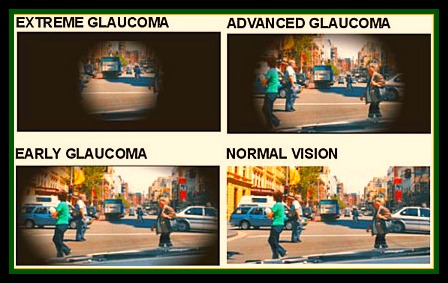 What is Glaucoma?
What is Glaucoma?Glaucoma is a group of eye disorders that cause gradual damage to the optic nerve, a bundle of more than 1 million nerve fibers that send images from the eye to the brain. A healthy optic nerve is necessary for good vision.
The most common form of the disease, primary open angle glaucoma, is associated with increased eye pressure, which can slowly damage the optic nerve. This eye pressure results from excessive fluid build-up in the front of the eye. A clear liquid flows continuously in and out of a space called the anterior chamber to nourish nearby tissues. When the drainage system is not working properly, fluid cannot leave the eye. As it builds up, so does eye pressure.
Who Gets Glaucoma?
Glaucoma can affect anyone regardless of age or ethnic background. Three groups, however, are particularly at risk: those with a family history of glaucoma, African Americans over age 40 and everyone over age 60, especially Hispanics.
The number of Americans with glaucoma is growing because of several trends that have increased the sizes of the major risk groups:
- Aging population: The Baby Boom generation is entering retirement age.
- Growth of African American and Hispanic populations: Glaucoma is five times more common among African Americans and Hispanics than among Caucasians.
- Ongoing obesity epidemic: Obesity accounts for the rising number of people with diabetes, who are twice as likely to develop glaucoma as those without diabetes.
With primary open angle glaucoma, the most common type, damage to the optic nerve is so gradual that there are no symptoms at first. When symptoms do appear, it is usually loss of peripheral vision. You are able to see straight ahead, but miss objects to the side, as if you were looking through a tunnel. If glaucoma is left untreated, serious vision loss may occur in both eyes. Over time, straight-ahead vision may diminish until none remains.
A less common form of the disease is acute angle closure glaucoma. It occurs suddenly as the result of a rapid increase in eye pressure. Symptoms include severe eye pain, nausea, eye redness, seeing colored halos around lights and blurred vision. This condition is a medical emergency requiring immediate treatment, as blindness can occur in just one or two days. Treatment is either medication or surgery to allow fluid to drain out of the eye.
How Is Glaucoma Diagnosed?
Glaucoma is diagnosed during a comprehensive eye exam. Your doctor will perform several different tests to look for eye problems and for changes in your eyes since your last exam:
- Dilated eye exam. After drops are placed in your eyes to dilate (widen) them, a magnifying lens is used to examine your retina and optic nerve.
- Visual acuity test. An eye chart test measures how well you see at various distances.
- Visual field test. Measures your peripheral (side) vision.
- Tonometry. Measures the pressure inside the eye.
- Pachymetry. Measures the thickness of the cornea.
If we feel that your eyes require further evaluation, we recommend that you schedule a full eye exam
with our in-house optometrist. Please note there is a charge for this
appointment. You are free to schedule an appointment with another
optometrist if you wish.
20/20 Eyeglass Superstore is a family operated business with three shops throughout central Florida. Our number one goal is to become your reliable source for eye care, glasses and contacts. Should you have any questions or comments, please feel free to contact us anytime.
Don’t forget to call ahead to make your appoint for your free vision screening in Orange City, Florida. This promotion runs from December 15th – December 24th, 2012.
Orange City 20/20 Eyeglass Superstore
1270 Saxon Blvd,
Orange City, FL 32763
Tel: 386-774-5000
20/20 Eyeglass Superstore is a family operated business with three shops throughout central Florida. Our number one goal is to become your reliable source for eye care, glasses and contacts. Should you have any questions or comments, please feel free to contact us anytime.
Don’t forget to call ahead to make your appoint for your free vision screening in Orange City, Florida. This promotion runs from December 15th – December 24th, 2012.
Orange City 20/20 Eyeglass Superstore
1270 Saxon Blvd,
Orange City, FL 32763
Tel: 386-774-5000
No comments:
Post a Comment